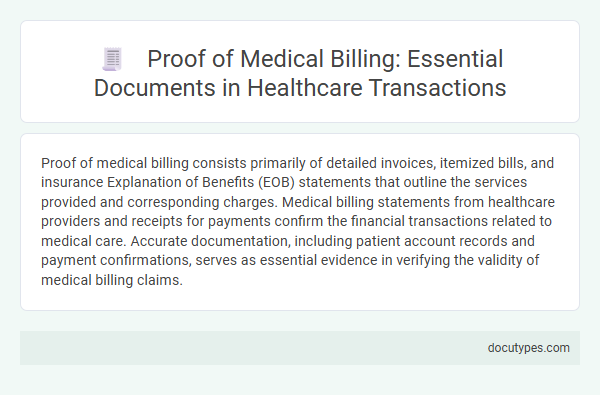Proof of medical billing consists primarily of detailed invoices, itemized bills, and insurance Explanation of Benefits (EOB) statements that outline the services provided and corresponding charges. Medical billing statements from healthcare providers and receipts for payments confirm the financial transactions related to medical care. Accurate documentation, including patient account records and payment confirmations, serves as essential evidence in verifying the validity of medical billing claims.
Introduction to Medical Billing Documentation
Medical billing documentation is essential for verifying the services provided and ensuring accurate reimbursement from insurance companies. These documents capture detailed information about patient care, procedures performed, and associated costs.
Common documents serving as proof include itemized bills, encounter forms, and detailed medical records that outline treatments and diagnoses. Proper documentation supports compliance with healthcare regulations and minimizes billing errors.
Importance of Proof of Medical Billing
Proof of medical billing is essential for verifying the accuracy and legitimacy of healthcare charges. Common documents serving this purpose include itemized bills, explanation of benefits (EOB), and receipts from healthcare providers.
These documents ensure transparency in your medical expenses and facilitate insurance claims or disputes. Maintaining proper proof of medical billing protects your rights and supports financial accountability in medical services.
Types of Documents in Healthcare Transactions
Medical billing relies on several key documents that serve as proof in healthcare transactions. Common types include itemized bills, insurance claim forms, and Explanation of Benefits (EOB) statements. These documents ensure transparency and accuracy in the billing and reimbursement process between providers, insurers, and patients.
Patient Registration and Demographics
Patient registration forms serve as primary proof of medical billing by capturing essential demographic information such as name, date of birth, and insurance details. These documents verify the identity and coverage of the patient, ensuring accurate billing and claim submissions. Accurate patient demographics minimize billing errors and facilitate timely reimbursement from insurance providers.
Insurance Verification Documents
Insurance verification documents are essential proof of medical billing, confirming a patient's coverage and eligibility. These documents include insurance cards, verification letters, and pre-authorization forms issued by the insurer.
Insurance verification documents validate the services billed by healthcare providers and facilitate accurate claim processing. They help ensure that the treatments or procedures fall within the patient's insurance benefits. Maintaining these records reduces the risk of denials and delays in reimbursement from insurance companies.
Medical Coding and Charge Capture Records
| Document Type | Description | Role in Medical Billing |
|---|---|---|
| Medical Coding Records | Detailed documentation of diagnosis and procedure codes (ICD, CPT, HCPCS) assigned to patient encounters. | Serve as the foundational proof for services rendered; ensure accurate billing by translating clinical information into billable codes. |
| Charge Capture Records | Data capturing all billable services, supplies, and procedures recorded during patient care. | Documented evidence for submitted charges; validate that all performed services are accounted for in the billing process. |
| Electronic Health Records (EHR) | Comprehensive patient medical history including provider notes, test results, and treatment plans. | Support the accuracy of coding and charge capture by providing clinical context and justification for billed services. |
| Claim Forms (CMS-1500, UB-04) | Standardized forms submitted to payers detailing coded services and charges. | Formalize billing claims; act as legal documents proving the submission of charges derived from coding and charge capture. |
Explanation of Benefits (EOB)
What documents serve as proof of medical billing? Explanation of Benefits (EOB) is a primary document provided by insurance companies detailing the services billed, amounts covered, and your financial responsibility. An EOB acts as a transparent record verifying medical claims processed and payments made or denied.
Patient Billing Statements
Patient billing statements serve as essential proof of medical billing by detailing services rendered and charges incurred. These documents provide transparent records for you to verify medical expenses and insurance claims.
- Itemized Bill - Lists each medical service or procedure with corresponding costs for clear expense tracking.
- Payment Summary - Shows payments made by the patient, insurance, or other parties, reflecting the balance due or overpaid.
- Insurance Explanation of Benefits (EOB) - Provides a breakdown of what the insurance covers versus what remains the patient's responsibility.
Payment Receipts and Remittance Advices
Proof of medical billing is essential for verifying payment transactions between healthcare providers and insurance companies or patients. Payment receipts and remittance advices are among the primary documents used to confirm these financial exchanges.
- Payment Receipts - These documents provide confirmation that a patient or insurer has made a payment towards medical services rendered.
- Remittance Advices - Issued by insurance companies, these documents detail the amount paid, denied claims, and any patient responsibility after claim processing.
- Record Keeping - Both documents are integral for maintaining accurate medical billing records and resolving discrepancies in payments or claims.
Payment receipts and remittance advices serve as critical evidence in ensuring transparency and accuracy within medical billing processes.
What Documents Serve as Proof of Medical Billing? Infographic

